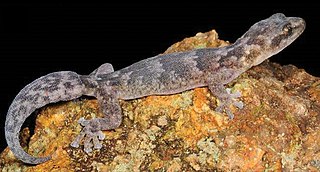
Afroedura is a genus of African geckos, lizards in the family Gekkonidae. Member species are collectively known as rock geckos or flat geckos.

Hemidactylus is a genus of the common gecko family, Gekkonidae. It has 195 described species, newfound ones being described every few years. These geckos are found in all the tropical regions of the world, extending into the subtropical parts of Africa and Europe. They excel in colonizing oceanic islands by rafting on flotsam, and are for example found across most of Polynesia. In some archipelagoes, cryptic species complexes are found. Geckos like to live in and out of houses. They have been introduced to Australia.

Acontias is a genus of limbless skinks, the lance skinks, in the African subfamily Acontinae. Most are small animals, but the largest member of the genus is Acontias plumbeus at approximately 40 cm (16 in) snout-vent length. All members of this genus are live-bearing sandswimmers, with fused eyelids. A recent review moved species that were formerly placed in the genera Typhlosaurus, Acontophiops, and Microacontias into this genus, as together these form a single branch in the tree of life. This new concept of Acontias is a sister lineage to Typhlosaurus, and these two genera are the only genera within the subfamily Acontinae.
Lubuya is a genus of skinks, lizards in the family Scincidae. The genus contains one species, Lubuya ivensii, known commonly as Ivens' skink, Ivens's skink, Ivens's water skink, or the meadow skink, which is native to Southern Africa.

Gerarda prevostiana, commonly known as the cat-eyed water snake, Gerard's water snake, and the glossy marsh snake, is a species of snake in the family Homalopsidae. The species is endemic to Asia. It is the only species in the genus Gerarda.

Ficimia is a genus of colubrid snakes commonly known as hooknose snakes or hook-nosed snakes, which are endemic to North America. There are seven species within the genus.
Günther's dwarf burrowing skink, also known commonly as Günther's burrowing skink, was a species of lizard in the family Scincidae. The species was endemic to Natal, South Africa.
The brown-snouted blind snake, also known commonly as Wied's blind snake, is a species of snake in the family Typhlopidae. The species is endemic to Australia.

Scaphiophis is a genus of African snakes in the family Colubridae. Common names include hook-nosed snakes and shovel-nosed snakes.

Dipsadoboa is a genus of snakes in the family Colubridae.
The Namib day gecko is a species of lizard in the family Gekkonidae. The species is found in the deserts of Namibia and southern Angola. It is the type species of the genus Rhoptropus.

Bogert's rock gecko is a species of lizard in the family Gekkonidae. The species is native to southern Africa.
Wahlberg's Kalahari gecko, also known commonly as the Kalahari ground gecko, is a species of lizard in the family Gekkonidae. The species is native to southern Africa.
Monopeltis is a genus of amphisbaenians in the family Amphisbaenidae. Species in the genus are commonly known as worm lizards, even though they are not lizards. The genus is endemic to southern Africa. 19 species are placed in this genus.

The black file snake, also known commonly as the dwarf file snake or the Nyassa file snake, is a species of snake in the subfamily Lamprophiinae of the family Lamprophiidae. The species is endemic to Africa.
Limaformosa is a genus of snakes, commonly known as file snakes, in the family Lamprophiidae. The genus is endemic to Africa.

Monopeltis anchietae, also known commonly as Anchieta's worm lizard, Anchieta's spade-snouted worm lizard, and the Angolan spade-snouted worm lizard, is a species of amphisbaenian in the family Amphisbaenidae. The species is native to southern Africa.
Dalophia welwitschii is a species of amphisbaenian in the family Amphisbaenidae. The species is endemic to Angola.

The shovel-snouted lizard, also known commonly as Anchieta's desert lizard, Anchieta's dune lizard and the Namib sand-diver, is a species of lizard in the family Lacertidae. The species is native to southern Africa.
Sepsina bayonii, also known commonly as Bayon's skink, is a species of lizard in the family Scincidae. The species is native to Central Africa and Southern Africa.











